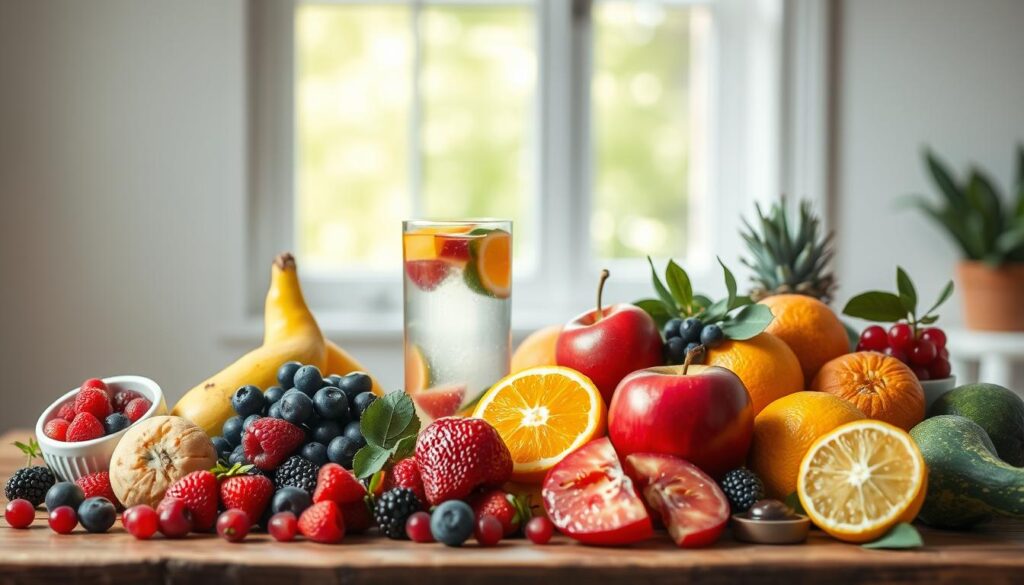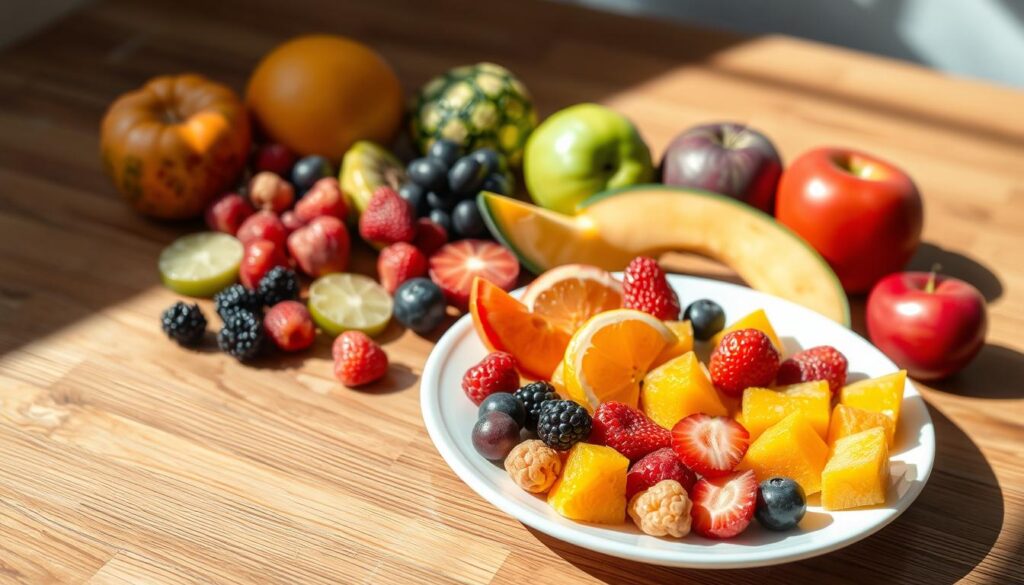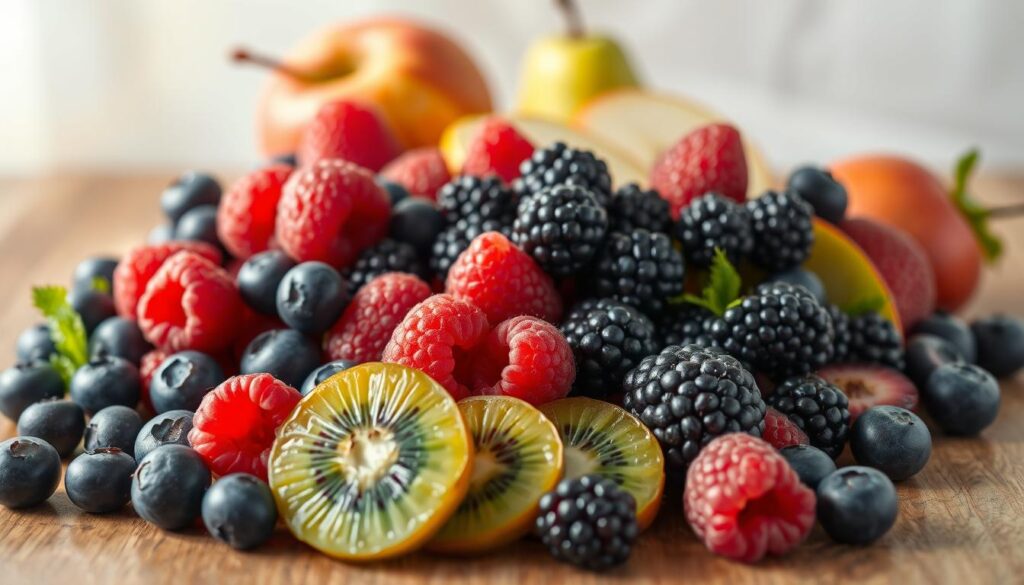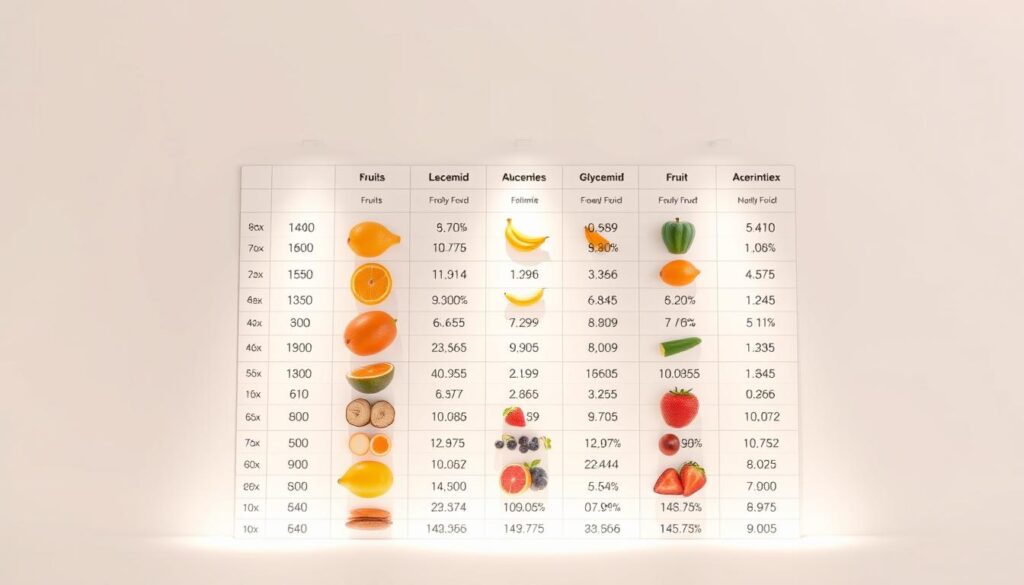
What Are the Best Fruits for Diabetes?
Can people with diabetes enjoy nature’s sweetest treats without harming their health? This question puzzles millions of Americans with diabetes every day. The answer isn’t just to avoid all sweet foods. Choosing the right foods is key for diabetic individuals. Some fruits can actually help control blood sugar. Others might cause spikes that mess up daily routines.
Unlock Your Best Health with Dr. Marlene Merritt’s "Smart Blood Sugar"!
Are you ready to take control of your blood sugar levels and transform your health? Join the thousands who have benefited from Dr. Merritt’s expert insights and practical strategies.
👉 Discover the Secrets: Learn how to stabilize your blood sugar naturally with simple dietary changes and smart lifestyle choices!
✨ Why Wait? Start your journey toward better health today! Click the link below to get your copy of “Smart Blood Sugar” and take the first step towards a vibrant life.
Take Action Now! Your path to wellness is just one book away!
Knowing which fruits are best helps make better choices. The right knowledge lets you plan meals that are tasty and healthy. People with diabetes should be able to enjoy a variety of foods without worry.
Always talk to your healthcare provider before changing your diet. They can give you advice that fits your needs and treatment plan.
Key Takeaways
- Certain natural sweet options can support blood sugar management for diabetic individuals
- Understanding nutritional content helps make informed dietary decisions
- Portion control remains essential regardless of the type chosen
- Individual responses vary, making personal monitoring important
- Healthcare provider consultation ensures safe dietary modifications
- Timing of consumption affects blood glucose impact significantly
Healthy Ways to Eat Fruits
Smart fruit eating habits can change diabetes management for the better. It’s all about knowing how to add fruits to your meals without raising blood sugar too high. Portion size is key to keeping blood sugar stable. A single serving of fruit is like one small apple, half a banana, or three-quarters cup of berries. These sizes help avoid eating too much while still getting the nutrients you need. When you eat fruits, timing is everything. Eating them with meals slows down how your body absorbs sugar. This helps avoid quick spikes in blood sugar that can happen when you eat fruits alone.

Mixing fruits with protein or healthy fats makes for a better balanced diet. Try apple slices with almond butter or berries with Greek yogurt. These combos slow down digestion and keep blood sugar steady.
Whole fruits are better for blood sugar control than processed ones. Fresh apples have fiber that fruit juice doesn’t. This fiber helps regulate how your body absorbs sugar, which is good for diabetes management.
Knowing the right serving sizes is important to avoid eating too much. One serving of grapes is about 17 grapes, and a serving of melon is one cup of cubed pieces. These specific amounts help you make the right portion size choices.
Eating fruits throughout the day instead of all at once helps keep blood sugar steady. This way, you follow a more balanced diet pattern.
Take action today by tracking how different fruits and eating times affect your blood sugar. Watch how your glucose levels change with different fruit combinations and timing. This info will help you find the best ways to eat fruits for your needs.
What are the best fruit choices for diabetes?
Enjoying fresh fruit with diabetes is all about picking the right ones. Look for fruits that are low glycemic and full of nutrients. These fruits help manage blood sugar and add natural sweetness to your diet.
Berries are at the top of the list for people with diabetes. Blueberries, strawberries, raspberries, and blackberries are full of fiber and antioxidants. They have a low gi rating, which means they raise blood sugar slowly.

Apples are another great choice for diabetes management. The fiber in apple skin helps slow down sugar absorption. Plus, the fruit’s natural compounds are good for your health. Opt for medium-sized apples and keep the peel on for the most benefits.
Citrus fruits like oranges, grapefruits, and lemons are also good. They’re full of vitamin C and fiber, with little effect on blood sugar. Their natural tartness is satisfying without adding extra sugars.
“The best fruits for diabetes are those that are high in fiber, low in sugar, and packed with nutrients that support overall health.”
Stone fruits like peaches, plums, and apricots are also good choices. They have natural fiber and low glycemic properties. This helps keep blood sugar levels steady all day.
Take action today by adding these fruits to your meals. Start with small portions and see how your body reacts. Keep a food diary to find out which fruits work best for you.
Benefits of Fruits for People With Diabetes
Fresh fruits are packed with nutrients that help manage blood glucose levels. They offer vitamins, minerals, and antioxidants that boost health. These foods are great for a diabetes-friendly diet.
Fruits have a lot of fiber, which is good for diabetes. Fiber slows down digestion and prevents quick blood sugar spikes. This helps the body handle carbohydrate intake better, easing the insulin load.
- Antioxidant protection – Vitamin C and flavonoids fight inflammation and prevent diabetes complications
- Essential minerals – Potassium is good for the heart, and magnesium helps with glucose use
- Natural hydration – They are full of water, keeping you hydrated
- Digestive support – Fiber keeps the gut healthy and helps absorb nutrients
Whole fruits have a different carbohydrate makeup than processed sugars. They have complex sugars, fiber, water, and nutrients. This mix releases glucose slowly, unlike refined sugars.
Some fruits may also help with insulin sensitivity. Berries have anthocyanins that might improve glucose use. Citrus fruits have hesperidin, which helps keep blood glucose levels healthy.
Fruits also have vitamins that boost the immune system. This is key for people with diabetes, who may get sick more often. B vitamins in fruits help turn carbohydrate into energy more efficiently.
Discover Effective Strategies to Manage your Blood Sugar Levels Naturally
Don’t miss out on the insights that can transform your diabetes care. Buy your copy today and start your journey toward better health and well-being!
Glycemic index
The glycemic index is a key tool for understanding how foods affect blood sugar. It shows how fast carbs raise glucose levels compared to pure glucose. Pure glucose is the standard.
The GI scale goes from 0 to 100. Foods with a low GI (55 or below) slowly raise blood sugar. Medium GI foods (56-69) cause moderate rises. Foods with a GI of 70 or above quickly raise blood glucose.

Knowing these categories helps you make better food choices. Take control of your diabetes management by picking the right foods. The GI system guides you in planning meals and managing blood sugar.
Key Takeaways
- The glycemic index measures how quickly foods raise blood glucose levels
- The scale runs from 0 to 100, with glucose as the reference standard
- Low GI foods (55 or below) cause gradual blood sugar increases
- Medium GI foods (56-69) create moderate glucose responses
- High GI foods (70+) produce rapid blood sugar spikes
- Using GI values helps with better meal planning and diabetes control
What are high glycemic index foods?
Foods with a high GI rating can cause a sudden spike in blood sugar. This makes managing diabetes harder. These foods score 70 or higher on the glycemic index scale. They digest quickly and enter the bloodstream fast.
High GI foods raise blood sugar levels quickly, within 15 to 30 minutes after eating. This is because the body turns its carbs into glucose fast. The pancreas has to work harder to make insulin for these sudden changes.
- White bread and refined cereals
- White rice and instant rice products
- Potatoes, especially when mashed or baked
- Watermelon and other high-sugar fruits
- Sports drinks and sodas
- Candy and processed sweets
The digestive system handles these foods differently than low GI foods. Their simple carbs need little breakdown before being absorbed. This leads to a quick flood of glucose that overwhelms the body’s natural systems.
People with diabetes struggle with high GI foods. Their bodies can’t make enough insulin or use it well to handle the quick glucose rush. This causes blood sugar levels to stay high for a long time. This can harm organs over time.
Glycemic Index vs. Glycemic Load
The glycemic index shows how fast foods raise blood sugar. Glycemic load includes portion size, giving a full picture. Many with type 2 diabetes only look at the glycemic index. But this overlooks a key part.
The glycemic index ranks foods from 0 to 100 based on blood sugar rise speed. It compares carbs from different foods. For instance, watermelon and white bread might have similar scores.
Glycemic load goes further. It looks at both carb quality and quantity in a serving. This gives a clearer view of blood sugar impact in everyday eating.
- Glycemic Index: Measures the speed of blood sugar rise using 50 grams of carbs
- Glycemic Load: Accounts for actual serving sizes people typically eat
- Real Impact: Shows true effect on blood glucose during digestion
Watermelon is a good example. It has a high glycemic index of 72. But, its glycemic load is just 4. This is because a typical serving has few carbs. Its high water content means you’d need to eat a lot to hit 50 grams of carbs.
For those with type 2 diabetes, both metrics are important. The digestion process impacts how quickly glucose enters the blood. Foods high in fiber slow this down, even with moderate glycemic index scores.
Understanding both glycemic index and glycemic load helps create more flexible meal plans while maintaining stable blood sugar levels.
The glycemic index of common fruits and vegetables
The glycemic index shows how different fruits and vegetables affect blood sugar. It helps people with diabetes pick the best foods for blood sugar control.
The American Diabetes Association suggests choosing foods with lower GI values. Foods with a GI of 55 or less are low. Medium GI foods are 56 to 69. High GI foods are 70 or above.
Most non-starchy vegetables have very low GI values. Leafy greens, broccoli, cauliflower, and bell peppers are great. Their GI values are usually below 15, helping keep glucose levels stable.
| Food Item | Glycemic Index | Category | Serving Size |
|---|---|---|---|
| Apple | 36 | Low | 1 medium |
| Orange | 43 | Low | 1 medium |
| Banana | 51 | Low | 1 medium |
| Grapes | 46 | Low | 1 cup |
| Watermelon | 72 | High | 1 cup |
Berries are among the lowest GI fruits. Strawberries have a GI of 40, and blueberries are 53. They add natural sweetness without causing blood sugar spikes. Some fruits have higher GI values and need careful portion control. Pineapple is 59, and ripe bananas can be 62.
Choose fruits and vegetables with lower glycemic index values to help maintain steady blood glucose levels throughout the day.
Root vegetables have different glycemic impacts. Sweet potatoes are 63, and regular potatoes can be 78. Carrots are 47 when raw.
Use this glycemic index information to plan balanced meals and snacks that support your diabetes management goals. Pair higher GI fruits with protein or healthy fats to slow glucose absorption. This helps keep blood sugar control better throughout the day.
High Glycemic Fruits
Did you know some of nature’s sweetest treats can raise your blood sugar faster than candy? Many think all-natural foods are safe. But, some have more sugar than you might think.
Watermelon, pineapple, and dates are among the worst offenders. They have lots of sugar that quickly gets into your blood. Dried fruit is even worse because drying removes water but keeps all the sugar.
Fruit juice causes the biggest spikes in blood sugar. Without fiber, the sugar in juice gets into your blood fast. One glass can have as much sugar as several whole fruits.
Eating these foods with protein or healthy fats can help. Try eating them after working out when your body uses sugar better.
Key Takeaways
- Watermelon, pineapple, and dates can cause rapid blood sugar spikes
- Dried fruit concentrates natural sugars, making portion control essential
- Fruit juice lacks fiber and causes faster glucose absorption than whole options
- Pairing sweet foods with protein or fats helps slow sugar absorption
- Post-workout timing allows better glucose utilization by muscles
- Moderation and mindful pairing strategies prevent dangerous spikes
Which fruits have a high glycemic index and should be limited or avoided?
Knowing which fruits to limit is key for managing diabetes and controlling blood sugar. Many popular fruits have high glycemic indexes. They can cause blood glucose levels to spike quickly.
Watermelon has a glycemic index of 72. It’s mostly water, but its sugars are concentrated. This means they quickly enter the bloodstream. The large amounts people eat make this effect worse.
Pineapple is another fruit to watch out for. Fresh pineapple has a glycemic index of 66. Canned pineapple in syrup can be even higher. The natural sugars and enzymes in pineapple cause a fast glucose response.
Cantaloupe and honeydew melons also need caution. They have glycemic indexes between 65-72. Their high water content doesn’t stop their sugars from being quickly absorbed.
Overripe bananas are a problem because their starch turns to sugar as they ripen. Green bananas have a lower glycemic index. But yellow bananas with brown spots can affect blood sugar levels a lot.
- Dates and dried fruits concentrate sugars through dehydration
- Fruit juices remove fiber while concentrating sugars
- Canned fruits in heavy syrup add extra sugars
- Fruit cocktails often contain added sweeteners
Complete avoidance isn’t always needed for these fruits. Eating small portions with protein or healthy fats can slow sugar absorption. It’s also important to consider when you eat these fruits. Eating them after exercise might be better.
People with diabetes react differently to these fruits. Some can handle small amounts better than others. Monitoring blood glucose helps figure out what works for you.
Working with your healthcare team is the best way to get advice. A registered dietitian can make a meal plan that fits your diabetes management needs. Don’t change your diet without talking to your doctor first. They know what’s best for you.
How Can I Pair High Glycemic Fruits Without Affecting Blood Sugar for My Diabetes?
Pairing high glycemic fruits with other foods can help manage blood sugar levels for people with diabetes. Adding protein sources to these fruits can prevent sudden spikes in blood sugar.
For example, Greek yogurt with watermelon or pineapple slows down sugar absorption. Nuts like almonds or walnuts paired with dates or raisins also work well. The healthy fats and protein in these combinations help control the fruit’s effect on blood glucose.
Fiber-rich foods are another great option. Adding chia seeds to mango smoothies or eating an apple with peanut butter can balance out the nutritional profile. These combinations help release energy steadily, avoiding quick spikes in blood sugar. When to eat these fruits is also important. Consuming higher glycemic fruits after exercise helps muscles use glucose better. Snacks like banana with cottage cheese after working out can aid in recovery while keeping blood sugar in check. Portion control is key even with smart pairings. Enjoying smaller servings of your favorite fruits with other foods is part of a balanced diet. This approach allows for variety without risking your diabetes management.
Take the first step towards better blood sugar management today!
Discover effective, natural strategies to regulate your blood sugar levels. Don’t miss out on the knowledge and resources that can transform your health. Order your copy now and start your journey to a healthier you!
